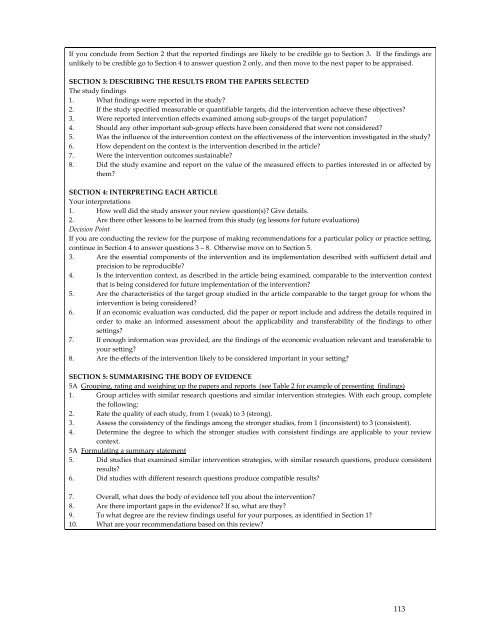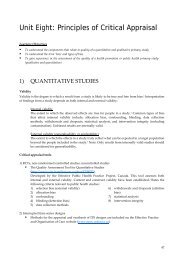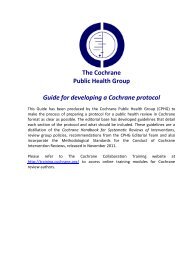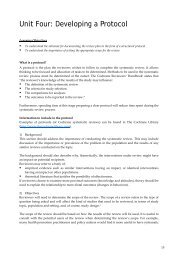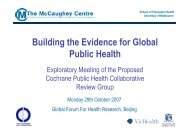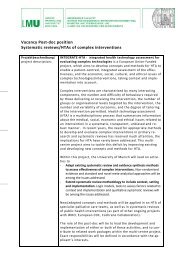Train the Trainer Course book - Cochrane Public Health Group
Train the Trainer Course book - Cochrane Public Health Group
Train the Trainer Course book - Cochrane Public Health Group
You also want an ePaper? Increase the reach of your titles
YUMPU automatically turns print PDFs into web optimized ePapers that Google loves.
If you conclude from Section 2 that <strong>the</strong> reported findings are likely to be credible go to Section 3. If <strong>the</strong> findings are<br />
unlikely to be credible go to Section 4 to answer question 2 only, and <strong>the</strong>n move to <strong>the</strong> next paper to be appraised.<br />
SECTION 3: DESCRIBING THE RESULTS FROM THE PAPERS SELECTED<br />
The study findings<br />
1. What findings were reported in <strong>the</strong> study?<br />
2. If <strong>the</strong> study specified measurable or quantifiable targets, did <strong>the</strong> intervention achieve <strong>the</strong>se objectives?<br />
3. Were reported intervention effects examined among sub-groups of <strong>the</strong> target population?<br />
4. Should any o<strong>the</strong>r important sub-group effects have been considered that were not considered?<br />
5. Was <strong>the</strong> influence of <strong>the</strong> intervention context on <strong>the</strong> effectiveness of <strong>the</strong> intervention investigated in <strong>the</strong> study?<br />
6. How dependent on <strong>the</strong> context is <strong>the</strong> intervention described in <strong>the</strong> article?<br />
7. Were <strong>the</strong> intervention outcomes sustainable?<br />
8. Did <strong>the</strong> study examine and report on <strong>the</strong> value of <strong>the</strong> measured effects to parties interested in or affected by<br />
<strong>the</strong>m?<br />
SECTION 4: INTERPRETING EACH ARTICLE<br />
Your interpretations<br />
1. How well did <strong>the</strong> study answer your review question(s)? Give details.<br />
2. Are <strong>the</strong>re o<strong>the</strong>r lessons to be learned from this study (eg lessons for future evaluations)<br />
Decision Point<br />
If you are conducting <strong>the</strong> review for <strong>the</strong> purpose of making recommendations for a particular policy or practice setting,<br />
continue in Section 4 to answer questions 3 – 8. O<strong>the</strong>rwise move on to Section 5.<br />
3. Are <strong>the</strong> essential components of <strong>the</strong> intervention and its implementation described with sufficient detail and<br />
precision to be reproducible?<br />
4. Is <strong>the</strong> intervention context, as described in <strong>the</strong> article being examined, comparable to <strong>the</strong> intervention context<br />
that is being considered for future implementation of <strong>the</strong> intervention?<br />
5. Are <strong>the</strong> characteristics of <strong>the</strong> target group studied in <strong>the</strong> article comparable to <strong>the</strong> target group for whom <strong>the</strong><br />
intervention is being considered?<br />
6. If an economic evaluation was conducted, did <strong>the</strong> paper or report include and address <strong>the</strong> details required in<br />
order to make an informed assessment about <strong>the</strong> applicability and transferability of <strong>the</strong> findings to o<strong>the</strong>r<br />
settings?<br />
7. If enough information was provided, are <strong>the</strong> findings of <strong>the</strong> economic evaluation relevant and transferable to<br />
your setting?<br />
8. Are <strong>the</strong> effects of <strong>the</strong> intervention likely to be considered important in your setting?<br />
SECTION 5: SUMMARISING THE BODY OF EVIDENCE<br />
5A <strong>Group</strong>ing, rating and weighing up <strong>the</strong> papers and reports (see Table 2 for example of presenting findings)<br />
1. <strong>Group</strong> articles with similar research questions and similar intervention strategies. With each group, complete<br />
<strong>the</strong> following:<br />
2. Rate <strong>the</strong> quality of each study, from 1 (weak) to 3 (strong).<br />
3. Assess <strong>the</strong> consistency of <strong>the</strong> findings among <strong>the</strong> stronger studies, from 1 (inconsistent) to 3 (consistent).<br />
4. Determine <strong>the</strong> degree to which <strong>the</strong> stronger studies with consistent findings are applicable to your review<br />
context.<br />
5A Formulating a summary statement<br />
5. Did studies that examined similar intervention strategies, with similar research questions, produce consistent<br />
results?<br />
6. Did studies with different research questions produce compatible results?<br />
7. Overall, what does <strong>the</strong> body of evidence tell you about <strong>the</strong> intervention?<br />
8. Are <strong>the</strong>re important gaps in <strong>the</strong> evidence? If so, what are <strong>the</strong>y?<br />
9. To what degree are <strong>the</strong> review findings useful for your purposes, as identified in Section 1?<br />
10. What are your recommendations based on this review?<br />
113


